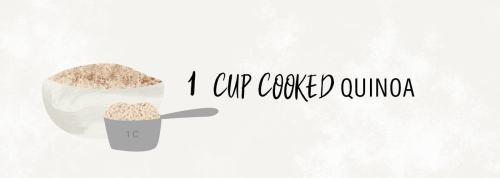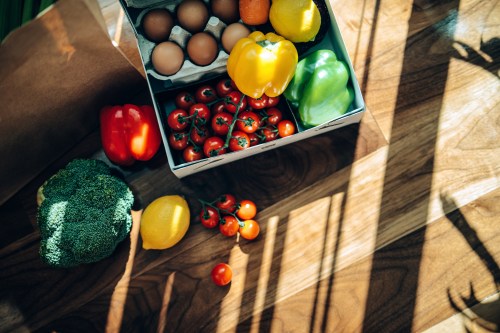Conventional wisdom (and most research) tells us that healthy eating requires eating balanced portions of a wide variety of foods, especially fruits and vegetables. Seems simple enough…except for the fact that what’s recommended on the back of a nutrition label isn’t always enlightening. And a lot of traditional serving size definitions are pretty unhelpful, tbh. (When was the last time you looked at a deck of cards as a size reference for anything?)
“Portion sizes can get a bit confusing, since a lot of nutrition labels talk in grams for portions and people don’t carry a food scale around in their back pocket,” says Brigitte Zeitlin, RD, owner of BZ Nutrition in New York City. “One serving can seem a bit abstract and not really a concrete visual to understand.”
Most of us tend to overestimate portions since we’re used to restaurant portions—which are actually more like double the recommended serving size, Zeitlin says. The one exception: vegetables, which most of us don’t get enough of. “I tell clients to double or sometimes triple the fresh veggies they have in a day,” she says. By doing so, you’ll edge closer to your recommended 25 grams daily grams of fiber, plus you’ll get a dose of antioxidants, vitamins, and minerals.
Not sure what a portion is? Here’s what a serving size actually looks like for 10 healthy foods you’re probably plopping in your grocery cart all the time.
1. Cashews

Serving size: 18 nuts
Once you start crunching, it can be hard to stop. “Nuts are notoriously overeaten in one sitting,” says Zeitlin. Rich in protein and inflammation-fighting omega 3 fatty acids, nuts are also packed with 157 calories in a one-ounce (or quarter cup) serving. The exact number of nuts per serving varies by the type of nut you’re eating, but a one-ounce serving of cashews is approximately 18 nuts.
2. Avocado

Serving size: 1/3 fruit
Avocado is another healthy fat that we all tend to overdo, says Zeitlin. (But in our defense, it tastes so good!) One serving of avocado is 1/3 of the fruit for 80 calories and three grams of heart-healthy fiber. While avocados vary in size, the 1/3 rule stands across the board: Larger avocados tend to have larger pits, so the amount of actual fruit you’re getting tends to be very similar.
Want to know even more about the benefits of avocado? Check out this episode of You vs Food:
3. Coconut oil

Serving size: One tablespoon
Coconut oil is a great swap for butter if you’re avoiding dairy or just want to switch up the flavors in your cuisine. Since it has a high smoke point, it tends to work well as a cooking oil. Just keep in mind that coconut oil is higher in saturated fat than olive oil, at 11 grams per one-tablespoon serving. “You definitely want to be cognizant of the amount you are using throughout the day. Heart health-wise, olive oil is still king, so keep your coconut oil to two tablespoons for the entire day,” says Zeitlin.
4. Nut butter

Serving size: Two tablespoons
“This can be either the easiest serving to get right, or the easiest one to overdo it on,” says Zeitlin. If you stick a spoon in a jar of almond butter and smear, you’re probably getting more like three to four tablespoons in two scoops, she says. But if you break out your measuring spoons or shell out for a single-serving nut butter packet, you can be sure you’re getting a two-tablespoon portion—and limiting yourself to 190 calories and 16 grams of (heart-healthy) fat.
5. Chicken breast

Serving size: Three to Four ounces
A serving of chicken could be a single breast—but it depends on the size of the chicken. A better way to nail down a single 3- to 4-ounce serving of meat is to compare it to the size and thickness of your palm. “Restaurants always tend to give a double portion of protein, so it’s a good idea to assume you will be taking half the dish home with you for the next day,” says Zeitlin. Throw leftovers in the next day’s salad or stir fry. If you’ve got less than a serving, Zeitlin suggests tossing shredded chicken in an omelet with veggies for a full serving of protein.
6. Greek yogurt

Serving size: 3/4 cup
Think a serving of yogurt is one cup? Welcome to the club! You’d be wrong. “A lot of people serve one cup, or eight ounces, in their parfaits and yogurt bowls, but that is just slightly larger than what it should be,” says Zeitlin. One serving is actually six ounces, or 3/4 cup, to guarantee the perfect amount of yogurt (and protein). If you don’t want to break out the measuring cups, opt for single-serving containers.
7. Quinoa

Serving size: One cup cooked
If you’re not using a measuring cup at home, one 1-cup serving of cooked grains—including quinoa, brown rice, wild rice, farro, etc.—is about the size of your closed fist. Most restaurants use the grain in buddha or poke bowls as a base, which means they’re probably dishing out way more than you need. “These bowls could easily equal your entire day’s servings of grains, or two to three cups total for the day, so you definitely want to keep an eye on the portion,” says Zeitlin.
8. Lentils

Serving size: 1/2 cup cooked
Unlike most other foods, it’s harder to overdo it on lentils: They’re dense in nutrients and fiber, so you’ll likely feel satisfied with a 1/2-cup serving (or about half the size of your fist). That said, it’s perfectly OK to double up on servings if you’re counting on legumes as a vegetarian protein source for the meal. “A full cup, or two servings, will give you 24 grams of protein and is still under 300 calories,” says Zeitlin.
9. Banana

Serving size: Eight inches long
One portion of any type of fruit is one cup, or roughly a medium banana. But what, exactly, is a medium banana? Measure it using the tip of the thumb to the first knuckle, which is about one inch; a medium banana is about eight inches long. Zeitlin says people should aim for two servings (two cups) of fruit total per day since it’s still a form of sugar. “We want to keep our sugar throughout the whole day in mind, and all the sources count,” says Zeitlin.
10. Dark chocolate

Serving size: One or Two squares
This is one food where it’s really only possible to know the portion size by checking the label. A single serving of dark chocolate is one ounce, which could mean one or two squares depending on the bar. To eliminate temptation, Zeitlin likes to pop single portions of dark chocolate in Ziploc bags to bring to work or stash away for dessert at home. Stick to 72 percent cacao or more to benefit from the heart-healthy fats and anxiety-busting magnesium while keeping sugar in check.
Got more food questions? Check out nutritionists’ answers to the most common ones they hear. And here’s the lowdown on the intermittent fasting fad.
Sign Up for Our Daily Newsletter
Get all the latest in wellness, trends, food, fitness, beauty, and more delivered right to your inbox.
Got it, you've been added to our email list.











